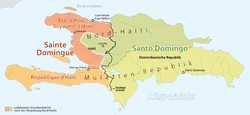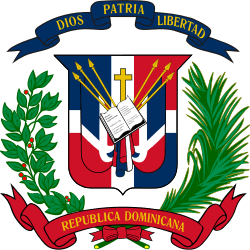Era de Francia
| Saint-Domingue | |||||||||
|---|---|---|---|---|---|---|---|---|---|
| 1795–1809 | |||||||||
 Northern Haiti in red, Southern Haiti in orange, Santo Domingo in green tones (the Cibao appears in dark green and the Ozama in light green). | |||||||||
| Status | Colony of France | ||||||||
| Capital | Santo Domingo | ||||||||
| Common languages | French, Spanish | ||||||||
| Government | Republic (1792-04); First Empire (1804-09) | ||||||||
| Governor | |||||||||
• 1801–1802 | Toussaint Louverture | ||||||||
• 1809 | Gen. Dubarquier | ||||||||
| History | |||||||||
• Peace of Basel | July 22 1795 | ||||||||
| July 9 1809 | |||||||||
| Area | |||||||||
| 76,192 km2 (29,418 sq mi) | |||||||||
| Currency | Saint-Domingue livre, Santo Domingo peso | ||||||||
| |||||||||
In the history of the Dominican Republic, the period of Era de Francia ("Era of France") occurred in 1795 when France acquired the Captaincy General of Santo Domingo, annexed it into Saint-Domingue and briefly came to acquire the whole island of Hispaniola by the way of the Treaty of Basel, allowing Spain to cede the eastern colony as a consequence of the French Revolutionary Wars.
During this time, it was also referred to as the French Santo Domingo.[3]
French rule
News that the Spanish colony had been ceded to France reached Santo Domingo in October 1795. Those who could not reconcile themselves to the new situation had up to a year to remove themselves to Cuba, Puerto Rico, or Venezuela, where they were to be given facilities to make a fresh start.[4] Between 1795 and 1810 some 125,000 persons are estimated to have left the Spanish sector of the island, leaving its population diminished by two-thirds compared with what it had been before the French Revolution.[4]
At the time, slaves led by Toussaint Louverture in Saint-Domingue (western colony) were in revolt against France. In 1801, Toussaint Louverture arrived in Santo Domingo, proclaiming the abolition of slavery on behalf of the French Republic and then captured Santo Domingo from the French, taking control of the entire island. Toussaint's army committed numerous atrocities; as a consequence, the Spanish population fled from Hispaniola in exodus proportions.[5] In 1802 an army sent by Napoleon under the command of Charles Leclerc, captured Toussaint Louverture and sent him to France as prisoner. In the event, the Dominicans collaborated with Leclerc and his French troops in order to expel the Haitians.[4] Toussaint's successors and yellow fever succeeded in expelling the French again from Saint-Domingue. The nation declared independence as Haiti in 1804. Even after the Haitians had defeated the French, a small French garrison remained in the former Spanish colony.
In 1805, after crowning himself Emperor, Jean-Jacques Dessalines invaded, reaching Santo Domingo before retreating in the face of a French naval squadron. The Haitians fell back through the settled area of the interior, sacking the towns of Monte Plata, Cotui and La Vega, and slaughtering the citizens of Moca and Santiago. They left the fields laid waste, the cities ablaze and the churches in ashes behind them.[4] In Moca only two people survived, thanks to corpses having been piled up on those still living in the church where the principal massacre took place.[4]
In October 1808 the rich landowner Juan Sánchez Ramírez, who had fled Santo Domingo during French rule to Puerto Rico, landed along the northeast coast and began a rebellion in the name of Ferdinand VII against the French colonial administrators in the city of Santo Domingo. The insurgents received aid from Spanish Puerto Rico and British Jamaica. The British blockaded the capital and occupied the port of Samaná. Sánchez defeated those loyal to France at Palo Hincado on November 7. On July 9, 1809, the British captured the city of Santo Domingo and as a consequence returned the eastern part of Hispaniola to Spanish rule.
Ironically, the Dominicans had gone to war against the French to restore Spanish rule to Santo Domingo just as the rest of Hispanic America was preparing to renounce Spanish colonialism. Moreover, the so-called War of Reconquest, following two invasions by the Haitians, had left the colony completely devastated.[4]
Governors (1801-1809)
- 1801-1802 Toussaint Louverture
- 1802-1803 Antoine Nicolas Kerverseau
- 1803-1808 Louis Marie Ferrand
- 1808-1809 L. Dubarquier
References
- ↑ Chartrand, René (1996). Napoleon’s Overseas Army (3rd ed.). Hong Kong: Reed International Books Ltd. ISBN 085045-900-1. Retrieved 22 August 2014.
- ↑ White, Ashli (2010). Encountering Revolution: Haiti and the Making of the Early Republic. Baltimore, Maryland, U. S. A.: The Johns Hopkins University Press. p. 63. ISBN 978-0-8018-9415-2.
- ↑ [1][2]
- 1 2 3 4 5 6 Bethell, Leslie (1984). The Cambridge History of Latin America: Volume 3. Cambridge University Press. pp. 245–48.
- ↑ Scheina, Robert L. (2003). Latin America's Wars: Volume 1. Potomac Books.

.svg.png)
